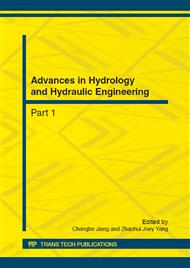p.55
p.59
p.63
p.68
p.72
p.78
p.83
p.88
p.99
Numerical Simulation of the Effects of Channel Regulation Engineering Works in the Tianxingzhou Reach of the Middle Yangtze River
Abstract:
The numerical simulation of the effects of regulation projects is presented through the discussion of: (a) the influenceingf actors of fairway conditions; (b) the plan of channel alignment works; (c) the establishment of a 2D numerical model; (d) the numerical simulation of the effects of regulation works. Base on measured data in recently years, Periodically erosion and deposition of Tianxingzhou head bench (THB) was determined as the key factor of navigation conditions. The navigation width would increase if THB maintain high and large morphology. Reflecting on the erosion trends of THB, pavement works with the main patterns of fishbone- bench protection belt to prevent the sand bar from erosion are proposed. The type of projects is fishbone- bench protection belt. The effects of regulation projects is predicted by using a 2D low-sediment mathematical model, which is verified by measured water and sediment data.With the mathematical model, the channel fluvial process and navigation development trend after the implementation of regulation projects in the next decade are simulated. THB maintain high level and integral morphology, which also guarantee good waterway conditions.
Info:
Periodical:
Pages:
72-77
Citation:
Online since:
October 2012
Authors:
Keywords:
Price:
Сopyright:
© 2012 Trans Tech Publications Ltd. All Rights Reserved
Share:
Citation:


